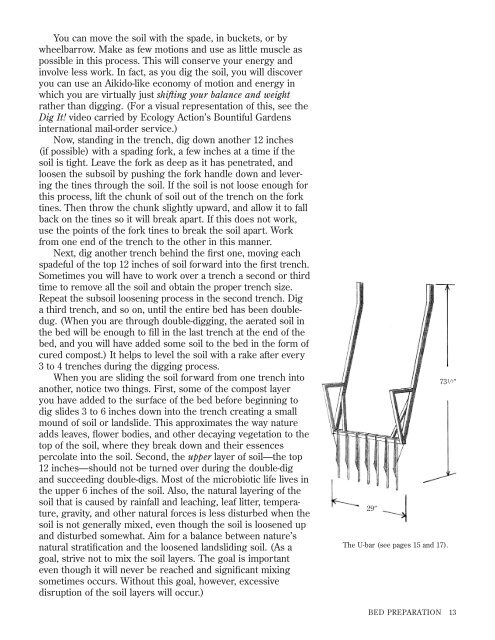How to Grow More Vegetables : And Fruits, Nuts ... - Shroomery
How to Grow More Vegetables : And Fruits, Nuts ... - Shroomery
How to Grow More Vegetables : And Fruits, Nuts ... - Shroomery
You also want an ePaper? Increase the reach of your titles
YUMPU automatically turns print PDFs into web optimized ePapers that Google loves.
You can move the soil with the spade, in buckets, or by<br />
wheelbarrow. Make as few motions and use as little muscle as<br />
possible in this process. This will conserve your energy and<br />
involve less work. In fact, as you dig the soil, you will discover<br />
you can use an Aikido-like economy of motion and energy in<br />
which you are virtually just shifting your balance and weight<br />
rather than digging. (For a visual representation of this, see the<br />
Dig It! video carried by Ecology Action’s Bountiful Gardens<br />
international mail-order service.)<br />
Now, standing in the trench, dig down another 12 inches<br />
(if possible) with a spading fork, a few inches at a time if the<br />
soil is tight. Leave the fork as deep as it has penetrated, and<br />
loosen the subsoil by pushing the fork handle down and levering<br />
the tines through the soil. If the soil is not loose enough for<br />
this process, lift the chunk of soil out of the trench on the fork<br />
tines. Then throw the chunk slightly upward, and allow it <strong>to</strong> fall<br />
back on the tines so it will break apart. If this does not work,<br />
use the points of the fork tines <strong>to</strong> break the soil apart. Work<br />
from one end of the trench <strong>to</strong> the other in this manner.<br />
Next, dig another trench behind the first one, moving each<br />
spadeful of the <strong>to</strong>p 12 inches of soil forward in<strong>to</strong> the first trench.<br />
Sometimes you will have <strong>to</strong> work over a trench a second or third<br />
time <strong>to</strong> remove all the soil and obtain the proper trench size.<br />
Repeat the subsoil loosening process in the second trench. Dig<br />
a third trench, and so on, until the entire bed has been doubledug.<br />
(When you are through double-digging, the aerated soil in<br />
the bed will be enough <strong>to</strong> fill in the last trench at the end of the<br />
bed, and you will have added some soil <strong>to</strong> the bed in the form of<br />
cured compost.) It helps <strong>to</strong> level the soil with a rake after every<br />
3 <strong>to</strong> 4 trenches during the digging process.<br />
When you are sliding the soil forward from one trench in<strong>to</strong><br />
another, notice two things. First, some of the compost layer<br />
you have added <strong>to</strong> the surface of the bed before beginning <strong>to</strong><br />
dig slides 3 <strong>to</strong> 6 inches down in<strong>to</strong> the trench creating a small<br />
mound of soil or landslide. This approximates the way nature<br />
adds leaves, flower bodies, and other decaying vegetation <strong>to</strong> the<br />
<strong>to</strong>p of the soil, where they break down and their essences<br />
percolate in<strong>to</strong> the soil. Second, the upper layer of soil—the <strong>to</strong>p<br />
12 inches—should not be turned over during the double-dig<br />
and succeeding double-digs. Most of the microbiotic life lives in<br />
the upper 6 inches of the soil. Also, the natural layering of the<br />
soil that is caused by rainfall and leaching, leaf litter, temperature,<br />
gravity, and other natural forces is less disturbed when the<br />
soil is not generally mixed, even though the soil is loosened up<br />
and disturbed somewhat. Aim for a balance between nature’s<br />
natural stratification and the loosened landsliding soil. (As a<br />
goal, strive not <strong>to</strong> mix the soil layers. The goal is important<br />
even though it will never be reached and significant mixing<br />
sometimes occurs. Without this goal, however, excessive<br />
disruption of the soil layers will occur.)<br />
29�<br />
73 1 ⁄ 2 �<br />
The U-bar (see pages 15 and 17).<br />
BED PREPARATION 13












